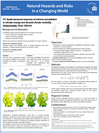PhD-Project P3 by Madlen Peter (née Fischer) (FU Berlin): Spatio-temporal response of extreme precipitation to climate change and decadal climate variability
Timescale: Oct. 2015 – Dec. 2021
Supervisors:
Prof. Dr. Matthias Holschneider, University of Potsdam
Prof. Dr. Henning Rust, Freie Universität Berlin
Prof. Dr. Uwe Ulbrich, Freie Universität Berlin
Background
Heavy precipitation can trigger landslides or lead to river flooding, but it can also cause flash floods and overspilling of urban sewerage systems. The type of potential hazard depends on the time scale considered: whereas flash floods and sewerage system overspills are related to a sub-daily time scale, landslides and river flooding are linked to daily or longer time scales. A typical question in this context is: What is the occurrence probability of heavy precipitation events? This question is answered with extreme value statistics, frequently point-wise in space, i.e. for a given station and time scale (temporal aggregation, e.g. hourly precipitation sums), assuming a stationary climate. As in large parts of Europe heavy precipitation events tend to increase in magnitude and frequency within a warming climate, the stationarity assumption can no longer be justified. In many cases the information on occurrence probability and intensity is needed also at locations without explicit rain gauge measurements. Furthermore, the frequency-size relations are not independent for various temporal scales, a property that can and should be exploited.
The problem of occurrence probability of natural hazards is often conceived and communicated as a stationary one. Particularly for climate-related hazards this assumption is prone to fail. Occurrence probabilities for heavy precipitation, extreme temperature or river flooding need to be treated as transient. Here, we apply a transient framework and aim to develop means of communicating transient occurrence probabilities. Particularly the latter is an overarching topic of NatRiskChange.
Objectives and Methods
This project aims at a probabilistic non-stationary, spatio-temporal description for extreme precipitation at various temporal scales; it thus belongs to the family of statistical modelling, although process modelling is also involved. The main outcome will be transient spatial maps of occurrence probabilities for various temporal aggregation levels dependent on the actual climate state. Basis of this description are non-stationary extreme value statistics for precipitation linked to large scale atmospheric circulation and with explicit modelling of the spatial domain, either via covariates or, alternatively, with a latent process model using Bayesian hierarchical modelling. The spatial description allows specifying occurrence probabilities at ungauged sites while borrowing strength from neighbouring sites. Furthermore, we aim to exploit the scaling relation between different temporal aggregates to obtain a better description along with improved occurrence (or exceeding) probability estimates and the possibility to extrapolate to particularly small/large temporal aggregates. The latter is particularly important for convective scale events causing, e.g., sewerage system overspill. The link to the large-scale atmospheric circulation allows obtaining occurrence probabilities dependent on the climate state, as obtained from climate change projections or deca-dal predictions. The latter is of relevance to stakeholders as it addresses the typical time horizon of infrastructure planning.
The PhD-project P3 is a cooperation between the research team “Climate diagnostics and extreme meteorological events” at Freie Universität Berlin and “Applied Mathematics” at the University of Potsdam.
Publications within NatRiskChange:
AGARWAL, A., BOESSENKOOL, B., FISCHER, M., Hahn, I., Köhn, L., LAUDAN, L., MORAN, T., OZTURK, U., Riemer, A., Rözer, V., SIEG, T., VOGEL, K., WENDI, D., Bronstert, A., Thieken, A.H. (2016): Die Sturzflut in Braunsbach, Mai 2016 - Eine Bestandsaufnahme und Ereignisbeschreibung. Taskforce im Rahmen des DFG-Graduiertenkollegs Natural Hazards and Risks in a Changing World, Universität Potsdam (Publisher), 20 pages, urn:nbn:de:kobv:517-opus4-394881.
Bronstert, A., AGARWAL, A., BOESSENKOOL, B., Crisologo, I., FISCHER, M., Heistermann, M., Köhn-Reich, L., López-Tarazón, J.A., MORAN, T., OZTURK, U., Reinhardt-Imjela, C. (2018): Forensic hydro-meteorological analysis of an extreme flash flood: The 2016-05-29 event in Braunsbach, SW Germany,Science of the Total Environment, 630: 977-991. doi.org/10.1016/j.scitotenv.2018.02.241.
Bronstert, A., AGARWAL, A., BOESSENKOOL, B., FISCHER, M., Heistermann, M., Köhn-Reich, L., MORAN T., WENDI, D. (2017): Die Sturzflut von Braunsbach am 29. Mai 2016 – Entstehung, Ablauf und Schäden eines „Jahrhundertereignisses“. Teil 1: Meteorologische und hydrologische Analyse, Hydrologie & Wasserbewirtschaftung, 61(3): 150-162, https://doi.org/10.5675/HyWa_2017,3_1.
FISCHER, M., Rust, H.W., Ulbrich, U. (2018): Seasonal Cycle in German Daily Precipitation Extremes, MetZet, 27(1): 3-13, https://doi.org/10.1127/metz/2017/0845.
FISCHER, M., Rust, H.W., Ulbrich, U. (2017): A spatial and seasonal climatology of extreme precipitation return-levels - A case study, Spatial Statistics, https://doi.org/10.1016/j.spasta.2017.11.007.

